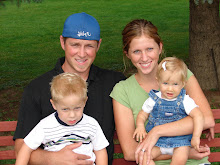Gosh, I am so excited to part of Cheri's refashionista event. Not only because I LOVE Cheri and her blog, but also because I love to refashion. I love NOT loading up all my kids, NOT getting overwhelmed at the fabric store and NOT paying a boat load of money just to sew.
My favorite thing to refashion is a T-Shirt. Everyone has some and they're made of knit which means I don't have to finish my edges. Today I wanted to share how to make a cardigan out of a long sleeve T-shirt.
With the weather getting colder I needed some cardigans to help carry our summer clothes over to fall and winter.
I started with a long sleeve T-shirt. Don't follow my horrid example. Your shirt should be washed and pressed.
First step is to line everything up so it's laying flat. Next cut two 1" strips.
Then I used one of my daughter's T-Shirts for a pattern. I turned it inside out and pinned it at the arm holes.
I find it easier to cut up both sides and half of the top, then fold it over and do the other half of the top. That way I know it's symmetrical.
While it was folded in half I cut the neck line a little lower.
Next, I pulled out the sleeves of my pattern shirt and laid them on the fold of my T-shirt. I gave myself a couple inches on the end since I wanted the sleeves to be a little longer than the pattern shirt. If you're pattern shirt is the right length line it up at the end of the sleeve. Once it's lined up, cut up to the armpit seams.
To cut the curve at the top of the sleeve, I lined up the arm hole from the body piece. After I cut one sleeve I used it as a pattern for the other sleeve.
Next I drew a line down the middle of my front body piece and cut it in half.
I also curved corners of the front opening.
Now I had all my pieces. Two 1" strips, two sleeves, a back and front with an opening.
I pinned and sewed the front and back right sides together at the shoulders. You can finish your edges with a serger, but it's not necessary.
Next, I sewed on the sleeves. I opened the shirt pieces and laid them flat with the right side up. Then I lined up the middle of the sleeve with the shoulder seam and pinned them right sides together. I followed the curve on both sides and pinned every half inch or so.
It will look like this when your done. It should be a perfect fit, be careful not to pull or stretch the knit.
After the sewing the arms on, I sewed up the sleeve and and down the sides.
At this point I had the basic shape of a cardigan, but the edges, need stability so they don't roll.
I pinned one of the 1" strips along the bottom of the cardigan. Then I sewed it on, first with a 1/8" seam along the bottom of the strip and then a 1/8" seam along the top.
It will look like this when your done. I like the look of the raw edges, they will curl a little over time and with washing.
Now I used my second 1" strip and pinned it up the front opening, around the back and down the front on the other side.
I pleated it to help it go around the curve at the neck line. I didn't have enough length in one strip to make it all the way around the neck and back down with the pleating. I used a leftover strip from the bottom to get the length I needed. I pieced them together and hid my seam in the pleats.
The last step is adding the pockets. I like to cut mine from the original neckline, so it will have the ribbing at the top.
I cut two out, pinned them in place, and sewed them on with a 1/8" seam.
You could also add buttons down the front. They're not functional, just for looks. I didn't want to wreck the whole thing by trying to do perfect button holes.
I know we are going to get a lot of use out of this. I think it would be pretty simple to do a boy version, maybe take out the curve and pleating. I would also like to try one out for myself, by cutting a shirt up the middle and cutting out the neckline. You would need a second shirt or extra knit fabric for your 1" strips.
Feel free to stop by anytime to see some more
refashions.
Thanks again Cheri, for inviting me to participate, I can't believe I'm blogging with some of the people I admire most.



 of ONE side seam on each pant peg that we just cut off. Set Aside.
of ONE side seam on each pant peg that we just cut off. Set Aside.















































